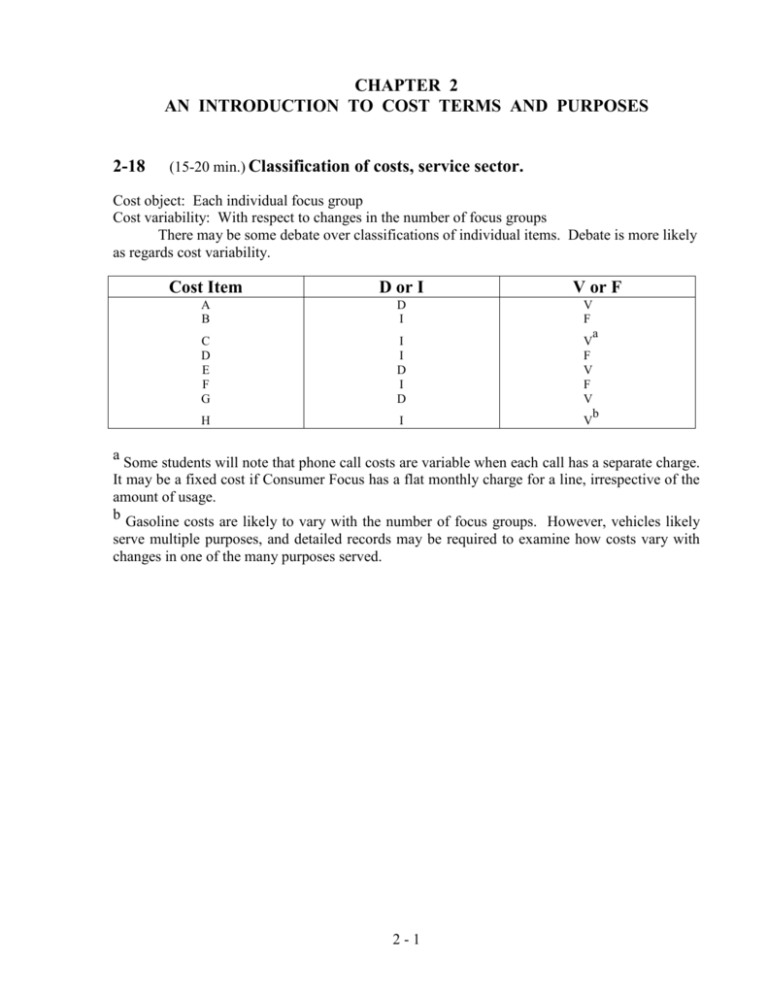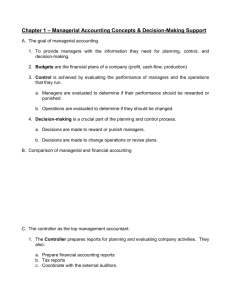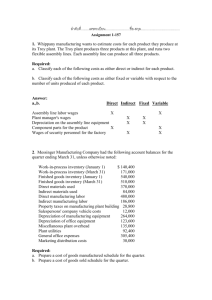here
advertisement

CHAPTER 2 AN INTRODUCTION TO COST TERMS AND PURPOSES 2-18 (15-20 min.) Classification of costs, service sector. Cost object: Each individual focus group Cost variability: With respect to changes in the number of focus groups There may be some debate over classifications of individual items. Debate is more likely as regards cost variability. Cost Item D or I A B D I V or F V F C D E F G I I D I D V F V F V H I V a b a Some students will note that phone call costs are variable when each call has a separate charge. It may be a fixed cost if Consumer Focus has a flat monthly charge for a line, irrespective of the amount of usage. b Gasoline costs are likely to vary with the number of focus groups. However, vehicles likely serve multiple purposes, and detailed records may be required to examine how costs vary with changes in one of the many purposes served. 2-1 2-23 (10-15 min.) Cost drivers and functions. 1. 1. 2. 3. 4. 5. 6. Function Accounting Personnel Data Processing Research and Development Purchasing Billing Representative Cost Driver F-Number of transactions processed E -Number of new hires D -Hours of computer processing unit (CPU) C-Number of research scientists B -Number of purchase orders A-Number of invoices sent 1. 2. 3. 4. 5. 6. Function Accounting Personnel Data Processing Research and Development Purchasing Billing Representative Cost Driver Hours of technical work Number of employees Number of computer transactions Number of new products being developed Number of different types of materials purchased Number of credit sales transactions 2. 2-26 (20-30 min.) Inventoriable costs versus period costs. 1. Manufacturing-sector companies purchase materials and components and convert them into different finished goods. Merchandising-sector companies purchase and then sell tangible products without changing their basic form. Service-sector companies provide services or intangible products to their customers—for example, legal advice or audits. Only manufacturing and merchandising companies have inventories of goods for sale. 2. Inventoriable costs are all costs of a product that are regarded as an asset when they are incurred and then become cost of goods sold when the product is sold. These costs for a manufacturing company are included in work-in-process and finished goods inventory (they are "inventoried") to build up the costs of creating these assets. Period costs are all costs in the income statement other than cost of goods sold. These costs are treated as expenses of the period in which they are incurred because they are presumed not to benefit future periods (or because there is not sufficient evidence to conclude that such benefit exists). Expensing these costs immediately best matches expenses to revenues. 1. (a) Mineral water purchased for resale by Safeway—inventoriable cost of a merchandising company. It becomes part of cost of goods sold when the mineral water is sold. (b) Electricity used at GE assembly plant—inventoriable cost of a manufacturing company. It is part of the manufacturing overhead that is included in the manufacturing cost of a refrigerator finished good. (c) Depreciation on AOL's computer equipment—period cost of a service company. AOL has no inventory of goods for sale and, hence, no inventoriable cost. 2-2 (d) Electricity for Safeway's store aisles—period cost of a merchandising company. It is a cost that benefits the current period and is not traceable to goods purchased for resale. (e) Depreciation on GE's assembly testing equipment—inventoriable cost of a manufacturing company. It is part of the manufacturing overhead that is included in the manufacturing cost of a refrigerator finished good. (f) Salaries of Safeway's marketing personnel—period cost of a merchandising company. It is a cost that is not traceable to goods purchased for resale. It is presumed not to benefit future periods (or at least not to have sufficiently reliable evidence to estimate such future benefits). (g) Water consumed by AOL's engineers—period cost of a service company. AOL has no inventory of goods for sale and, hence, no inventoriable cost. (h) Salaries of AOL's marketing personnel—period cost of a service company. AOL has no inventory of goods for sale and, hence, no inventoriable cost. 2-3 2-28 (30-40 min.) Cost of goods manufactured. 1. Canseco Company Schedule of Cost of Goods Manufactured for the Year Ended December 31, 2004 (in thousands) Direct materials costs: Beginning inventory, Jan. 1, 2004 Purchases of direct materials Cost of direct materials available for use Ending inventory, Dec. 31, 2004 Direct materials used Direct manufacturing labor costs Indirect manufacturing costs: Indirect manufacturing labor costs Plant insurance Depreciation––plant building and equipment Repairs and maintenance––plant Manufacturing costs incurred during 2004 Add beginning work-in-process inventory, Jan. 1, 2004 Total manufacturing costs to account for Deduct ending work-in-process inventory, Dec. 31, 2004 Cost of goods manufactured 2. $22,000 75,000 97,000 26,000 $ 71,000 25,000 15,000 9,000 11,000 4,000 39,000 135,000 21,000 156,000 20,000 $136,000 Canseco Company Income Statement for the Year Ended December 31, 2004 (in thousands) Revenues Cost of goods sold: Beginning finished goods, Jan. 1, 2004 Cost of goods manufactured (requirement 1) Cost of goods available for sale Ending finished goods, Dec. 31, 2004 Gross margin Operating costs: Marketing, distribution, and customer service General and administrative Operating income 2-4 $300,000 $ 18,000 136,000 154,000 23,000 93,000 29,000 131,000 169,000 122,000 $ 47,000 2-36 (30 min.) Comprehensive problem on unit costs, product costs. 1. If 2 pounds of direct materials are used to make each unit of finished product, 100,000 units × 2 lbs., or 200,000 lbs. were used at $0.70 per pound of direct materials ($140,000 ÷ 200,000 lbs.). (The direct material costs of $140,000 are direct materials used, not purchased.) Therefore, the ending inventory of direct materials is 2,000 lbs. $0.70 = $1,400. 2. Manufacturing Costs for 100,000 units Variable Fixed Total $140,000 $ – $140,000 30,000 – 30,000 5,000 – 5,000 10,000 16,000 26,000 8,000 24,000 32,000 $193,000 $40,000 $233,000 $233,000 ÷ 100,000 units = $2.33 per unit Direct materials costs Direct manufacturing labor costs Plant energy costs Indirect manufacturing labor costs Other indirect manufacturing costs Cost of goods manufactured Average unit manufacturing cost: $20,970 (given ) $2.33 per unit = 9,000 units Finished goods inventory in units: 3. Units sold in 2004 = Beginning inventory + Production – Ending inventory = 0 + 100,000 – 9,000 = 91,000 units Selling price per unit in 2004 = $436,800 ÷ 91,000 = $4.80 per unit 4. Revenues (91,000 units sold × $4.80) Cost of units sold: Beginning finished goods, Jan. 1, 2004 Cost of goods manufactured Cost of goods available for sale Ending finished goods, Dec. 31, 2004 Gross margin Operating costs: Marketing, distribution, and customer-service costs Administrative costs Operating income $436,800 $ 0 233,000 233,000 20,970 162,850 50,000 Note: Although not required, the full set of unit variable costs is: Direct materials costs $1.40 Direct manufacturing labor costs 0.30 Plant energy costs 0.05 Indirect manufacturing labor costs 0.10 Other indirect manufacturing costs 0.08 Marketing, distribution, and customer-service costs 2-5 $1.35 212,030 224,770 212,850 $ 11,920 Per unit manufactured Per unit sold 2-39 (30 min.) Missing data. (in millions) 1. Direct materials inventory, 8/1/2004 Direct materials purchased Direct materials available Deduct direct materials used Direct materials inventory, 8/31/2004 90 360 450 375 $ 75 2. Total manufacturing overhead costs Variable manufacturing overhead costs Fixed manufacturing overhead costs $ 480 250 $ 230 3. Total manufacturing costs Deduct: Direct materials used Manufacturing overhead Direct manufacturing labor costs $1,600 4. $375 480 Work-in-Process inventory, 8/1/2004 Total manufacturing costs 855 $ 745 Deduct cost of goods manufactured Work-in-Process inventory 8/31/2004 $ 200 1,600 1,800 1,650 $ 150 5. Finished goods inventory 8/1/2004 Cost of goods manufactured Goods available for sale $ 125 1,650 $1,775 6. Goods available for sale Deduct cost of goods sold Finished goods inventory, 8/31/2004 $1,775 1,700 $ 75 2-6




